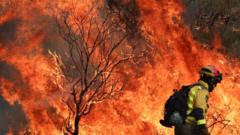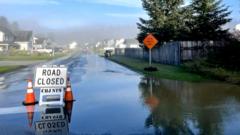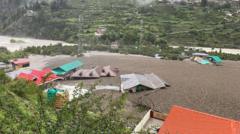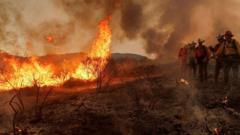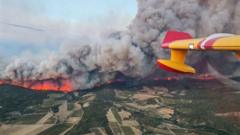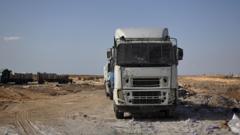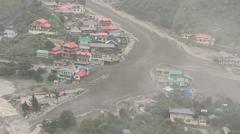In recent days, catastrophic flash floods have resulted in at least 164 fatalities across Pakistan and neighbouring Kashmir, with the death toll expected to rise as rescue efforts continue.
Tragic Flash Floods Claim Over 160 Lives in Pakistan and Kashmir
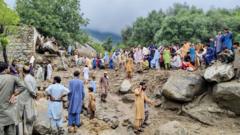
Tragic Flash Floods Claim Over 160 Lives in Pakistan and Kashmir
Severe monsoon floods lead to widespread devastation across northern regions.
Heavy monsoon rains have unleashed havoc in parts of Pakistan and Pakistan-administered Kashmir, with disaster authorities reporting a staggering loss of life over the past 24 hours. The majority of the deaths—150—occurred in the mountainous province of Khyber Pakhtunkhwa, where these floods have wreaked havoc, leaving at least 30 homes destroyed. Tragically, a rescue helicopter tasked with aiding operations also crashed, claiming the lives of its five crew members.
In Pakistan-administered Kashmir, nine individuals lost their lives, while five more died in the northern Gilgit-Baltistan region. As forecasters warn of ongoing heavy rainfall expected until August 21, authorities have declared several regions disaster zones, signalling the urgent need for humanitarian assistance.
The chief minister of Khyber Pakhtunkhwa, Ali Amin Gadapur, confirmed that a crash involving the M-17 helicopter was attributed to adverse weather while it was on a mission to assist the flood-stricken Bajaur area, close to the border with Afghanistan. On the ground in Bajaur, grieving residents gathered around an excavator working to clear away the mud, while funeral prayers were held for victims covered with blankets.
The situation is similarly grim in the Indian-administered part of Kashmir, where rescuers have been painstakingly retrieving bodies from the wreckage of a devastated Himalayan village following a recent flood, adding at least 60 to the death toll.
Typically, the monsoon rains between June and September account for three-quarters of South Asia's annual precipitation, leading to frequent flooding and landslides. This year's monsoon season has been particularly deadly, with over 300 reported deaths attributed to weather-related disasters. In July alone, Punjab, which houses nearly half of Pakistan's 255 million residents, saw a 73% increase in rainfall compared to the previous year, resulting in an equally alarming rise in fatalities.
Experts attribute the increasing severity and frequency of such catastrophic weather events to climate change, raising significant concerns about future rainfall patterns and disaster preparedness in the region.
In Pakistan-administered Kashmir, nine individuals lost their lives, while five more died in the northern Gilgit-Baltistan region. As forecasters warn of ongoing heavy rainfall expected until August 21, authorities have declared several regions disaster zones, signalling the urgent need for humanitarian assistance.
The chief minister of Khyber Pakhtunkhwa, Ali Amin Gadapur, confirmed that a crash involving the M-17 helicopter was attributed to adverse weather while it was on a mission to assist the flood-stricken Bajaur area, close to the border with Afghanistan. On the ground in Bajaur, grieving residents gathered around an excavator working to clear away the mud, while funeral prayers were held for victims covered with blankets.
The situation is similarly grim in the Indian-administered part of Kashmir, where rescuers have been painstakingly retrieving bodies from the wreckage of a devastated Himalayan village following a recent flood, adding at least 60 to the death toll.
Typically, the monsoon rains between June and September account for three-quarters of South Asia's annual precipitation, leading to frequent flooding and landslides. This year's monsoon season has been particularly deadly, with over 300 reported deaths attributed to weather-related disasters. In July alone, Punjab, which houses nearly half of Pakistan's 255 million residents, saw a 73% increase in rainfall compared to the previous year, resulting in an equally alarming rise in fatalities.
Experts attribute the increasing severity and frequency of such catastrophic weather events to climate change, raising significant concerns about future rainfall patterns and disaster preparedness in the region.


